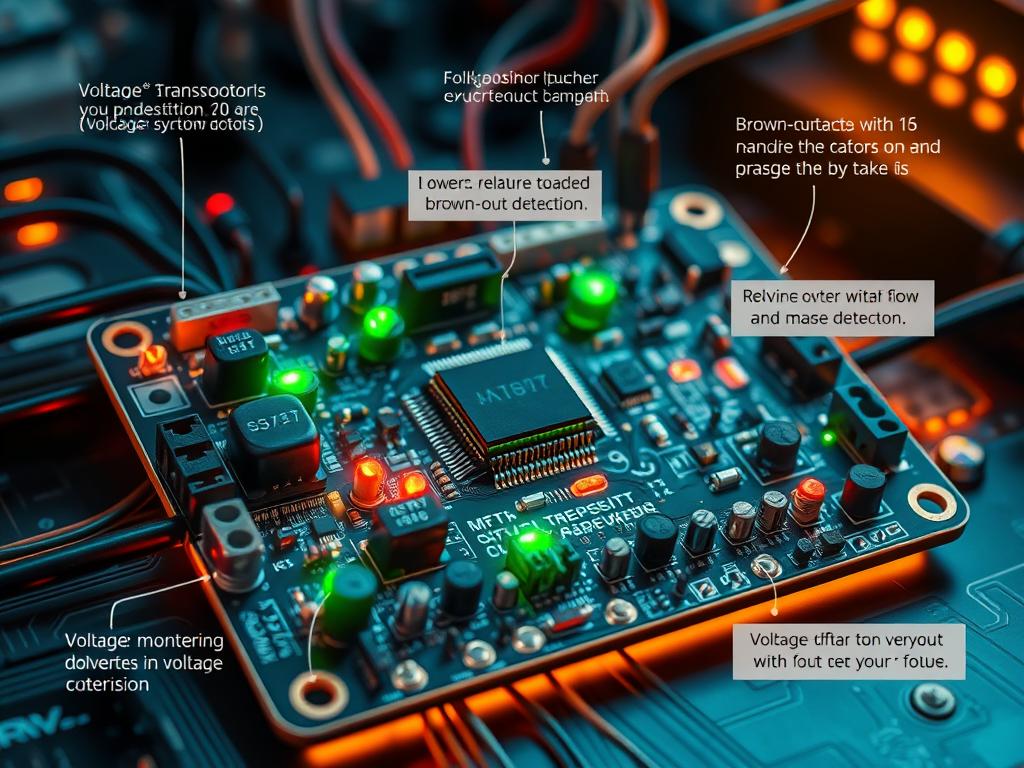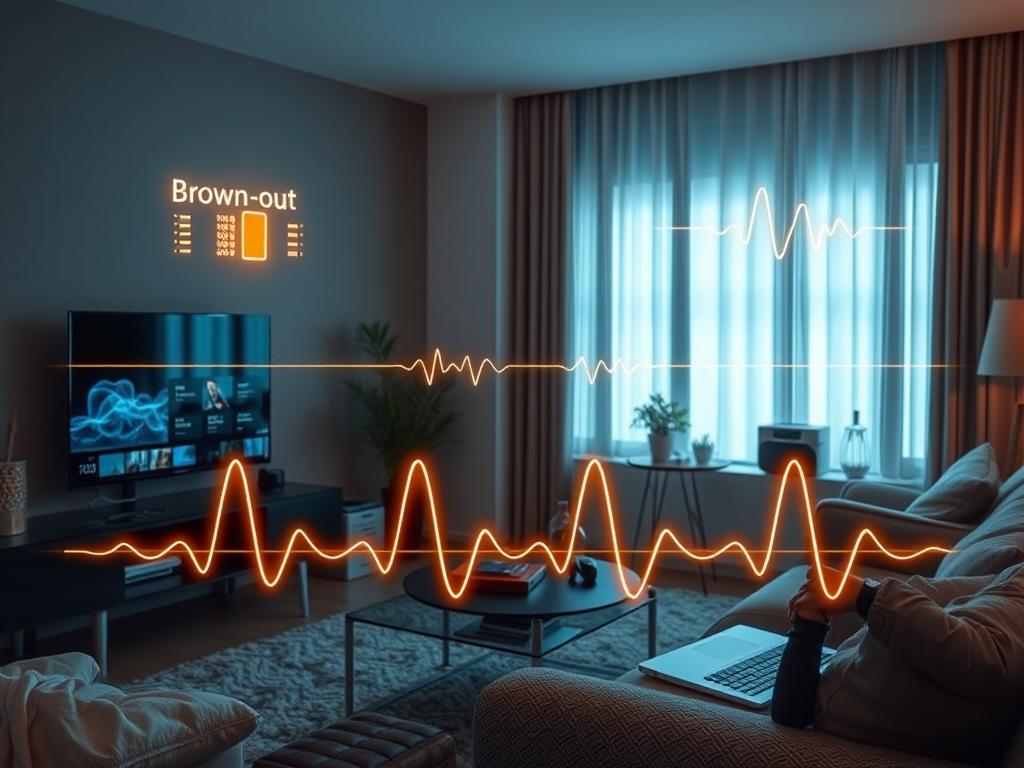Power failures often use 90% of capacitor charge as the action point. This threshold shows why reliable transistor circuits matter in voltage monitoring. Brown-out detection keeps systems stable during power changes.
Microprocessor supervisory circuits range from simple reset chips to complex devices. Their main job is power-on-reset (POR), which helps during power-up or voltage drops. Old methods using resistor-capacitor-diode combos have problems with accuracy and reliability.
New brown-out detection systems offer better control. The ESP32-S2 microcontroller has a brown-out detector with options from 2.44V to 3.30V. Setting it to 3.19V keeps the chip safe until VDD reaches 3.30V.
Good brown-out detection needs careful part selection and circuit design. Using reliable transistor circuits and advanced monitoring improves power supply stability. This protects sensitive electronics from harmful voltage changes.
Understanding Brown-Out Conditions
Brown-out conditions challenge low-power design and circuit robustness. They can disrupt normal system operations. Engineers must understand their nature and impact.
What is a Brown-Out?
A brown-out happens when supply voltage drops below the required level. This can cause data corruption and system malfunction. It’s especially risky for devices with low-power transistors.
Brown-out detection circuits help maintain system integrity. They play a crucial role in preventing issues.
Causes of Brown-Outs
Several factors can trigger brown-out conditions:
- Inadequate power regulation
- Powering up or down system components
- Software bugs
- Interrupted battery connections in portable devices
These issues show why proper transistor biasing is important. Good circuit design can prevent unexpected voltage drops.
Differences Between Brown-Outs and Blackouts
Brown-outs and blackouts both involve power issues. However, they differ in severity and duration:
| Aspect | Brown-Out | Blackout |
|---|---|---|
| Voltage Level | Reduced | Complete Loss |
| Duration | Short-term | Can be prolonged |
| System Impact | Potential malfunction | Total shutdown |
| Recovery | Often automatic | Manual restart required |
Understanding these differences is key for effective brownout reset mechanisms. It also ensures overall circuit robustness.
Accurate brown-out detection is vital as systems use lower power supply voltages. Many systems have unregulated voltage between 0.9 to 5.0 volts.
This is often regulated to 1.2V ± 10%. When it drops below 1.2V, most circuits stop working.
Effective brown-out detection is essential for maintaining data integrity and system reliability in low-power designs.
Robust brown-out detection circuits enhance reliability in low-power designs. They ensure smooth operation even under challenging power conditions.
The Importance of Brown-Out Detection
Brown-out detection is crucial for electrical system integrity. It protects against data corruption and system malfunctions from voltage drops. This feature is vital for embedded systems and devices needing consistent power supply stability.

Impact on Electrical Devices
Brown-out detection circuits activate when power supply voltage drops too low. They generate reset signals, setting system logic to a known state. This process is essential for SRAMs, which need minimum voltage to keep data.
As voltage levels in modern devices decrease, precise brown-out detection becomes more important. It ensures proper device function even during power fluctuations.
Safety and Performance Considerations
Brown-out detection prevents data loss and enhances transient immunity in electronics. It ensures devices restart correctly after voltage dips. This improves overall system reliability and safety in electronic devices.
“Proper brown-out detection is like a safety net for your electronic devices, catching them before they fall into unpredictable behavior due to low voltage conditions.”
Let’s explore some key statistics related to brown-out detection:
| Feature | Specification | Impact |
|---|---|---|
| Component Tolerance | ±5% to ±10% | Affects accuracy of traditional RC POR circuits |
| Hysteresis | ~100mV | Prevents false resets during voltage fluctuations |
| Modern IC Accuracy | ±0.5% | Improves reliability in power supply monitoring |
| Operating Temperature | -40 to 125°C | Ensures wide-range functionality in various applications |
These advancements in brown-out detection technology are vital for modern electronic systems. They maintain integrity and performance across various applications. Improved accuracy and wider operating ranges enhance overall system reliability.
Reliable Transistor Circuit Design
Designing reliable transistor circuits for voltage monitoring and protection requires careful planning. We’ll explore the key elements of an effective brown-out detection system. These circuits play a crucial role in safeguarding electronic devices.
Key Components in Transistor Circuits
A robust brown-out detection circuit uses several important components. These include a supply voltage detector, reference voltage generator, and inverters. Delay circuits and feedback PMOS transistors are also essential.
These parts work together to monitor voltage levels. They trigger protective measures when needed. The supply voltage detector creates a low internal reset signal based on voltage.
Selecting the Right Transistor for Detection
Choosing the right transistor is crucial for accurate voltage monitoring. The circuit design should consider both NMOS and PMOS transistor thresholds. This ensures precise tracking of variations with temperature and process.
Proper transistor biasing is essential for optimal performance. It helps maintain the transistor in its active region for accurate detection.
Circuit Operation Basics
The brown-out detection circuit generates reference voltages using feedback PMOS transistors and resistors. It compares the supply voltage to these reference levels. When voltage drops below the threshold, it triggers a reset signal.
The circuit applies asymmetric delays to rising and falling edges of the reset signal. This ensures a minimum reset pulse width. It can also stretch the reset signal during short supply brownouts.
By setting upper and lower trip points dynamically, the circuit adapts to various voltage changes. This enhances its reliability in diverse conditions, making it suitable for many applications.
Applications of Brown-Out Detection
Brown-out detection maintains power supply stability across various sectors. It ensures circuit robustness in diverse environments. This technology is vital for everyday gadgets and complex industrial systems.
Consumer Electronics
Brown-out detection is crucial for device longevity and performance in consumer electronics. Portable devices like smartphones use this tech to maintain stable operation. Brown-out detection circuits monitor voltage levels in these devices.
They trigger protective measures when power dips below critical thresholds. This helps prevent issues caused by battery connection problems.

Industrial Automation
Industrial automation systems rely on brown-out detection to guard against power fluctuations. These circuits ensure critical processes continue uninterrupted during minor power disturbances. In data processing, brown-out detection preserves memory contents, especially in SRAM applications.
Automotive Systems
The auto industry uses brown-out detection in embedded systems for vehicle safety and performance. These circuits protect sensitive electronics from voltage drops. They ensure critical systems like engine management operate reliably.
Modern electric vehicles use advanced brown-out detection too. It helps manage power distribution efficiently across various subsystems.
“Brown-out detection is the unsung hero of power stability in modern electronics, silently safeguarding our devices from the perils of voltage fluctuations.”
As tech advances, brown-out detection grows more important. It maintains circuit robustness across these applications. This drives innovation in power management and system reliability.
Implementing Brown-Out Detection Circuits
Brown-out detection circuits are vital for reliable transistor circuits in low-power design. They monitor voltage levels to prevent system failures during power fluctuations. These components play a crucial role in maintaining system stability.
Designing a Simple Circuit
A basic brown-out detection circuit uses standard NPN transistors and resistors. The NCP101X series integrates a fixed-frequency controller and a 700V MOSFET. This reliable transistor circuit switches at frequencies between 65-130 kHz during normal operation.
Circuit Testing and Validation
Testing brown-out detection circuits involves simulating various power conditions. Key aspects include verifying skip cycle occurrence and checking for acoustic noise generation.
Other important tests are validating rising edge interrupts for time base generation. Checking timer frequency for A/D conversion is also crucial.
- Verifying skip cycle occurrence at 1/4 of the maximum peak value
- Checking for acoustic noise generation
- Testing rising edge interrupts for time base generation
- Validating timer frequency for A/D conversion
Common Challenges in Implementation
Implementing brown-out detection faces several hurdles. Electrical Overstress (EOS) often causes microcontroller failure. Thermal stress can impact reliability.
Software-related issues and memory corruption pose additional challenges. These problems require careful consideration during design and implementation.
| Challenge | Prevention Strategy |
|---|---|
| EOS | Proper voltage regulation, ESD protection |
| Thermal Stress | Thermal management, temperature sensors |
| Software Failures | Robust error handling, code reviews |
| Memory Corruption | ECC memory, watchdog timers |
Addressing these challenges creates robust brownout reset systems that enhance overall circuit reliability. Additional detection circuitry costs between $0.25 and $0.35 per unit. This makes it a cost-effective solution for improving system stability.
Future Trends in Brown-Out Detection
Brown-out detection is rapidly changing due to advances in semiconductor technology. Modern electronic devices need better transient immunity and low-power design. These improvements are expected in the near future.
Advances in Semiconductor Technology
New semiconductor tech is improving brown-out detection circuits. Power-on-Reset (PoR) circuits with programmable trip are becoming more common. These use reference voltage generators for precise monitoring and faster responses.
CMOS circuits now have asymmetric rise and fall delays. This enhances supply monitoring abilities. It ensures reliable operation even during short supply brown-outs.
Integration with IoT Solutions
The Internet of Things (IoT) is changing brown-out detection strategies. Embedded systems are more connected, needing smart power management solutions. Future circuits will likely work seamlessly with IoT platforms.
This integration allows remote monitoring of power supply conditions. It enables proactive maintenance and improves system reliability in various applications. These range from consumer electronics to industrial automation.
Power supply voltages are decreasing with new process technologies. This makes accurate and efficient brown-out detection more important. Circuit design is focusing on low power use and high transient immunity.
The future of brown-out detection is in smart, energy-efficient solutions. These will adapt to the changing needs of modern electronic systems.


